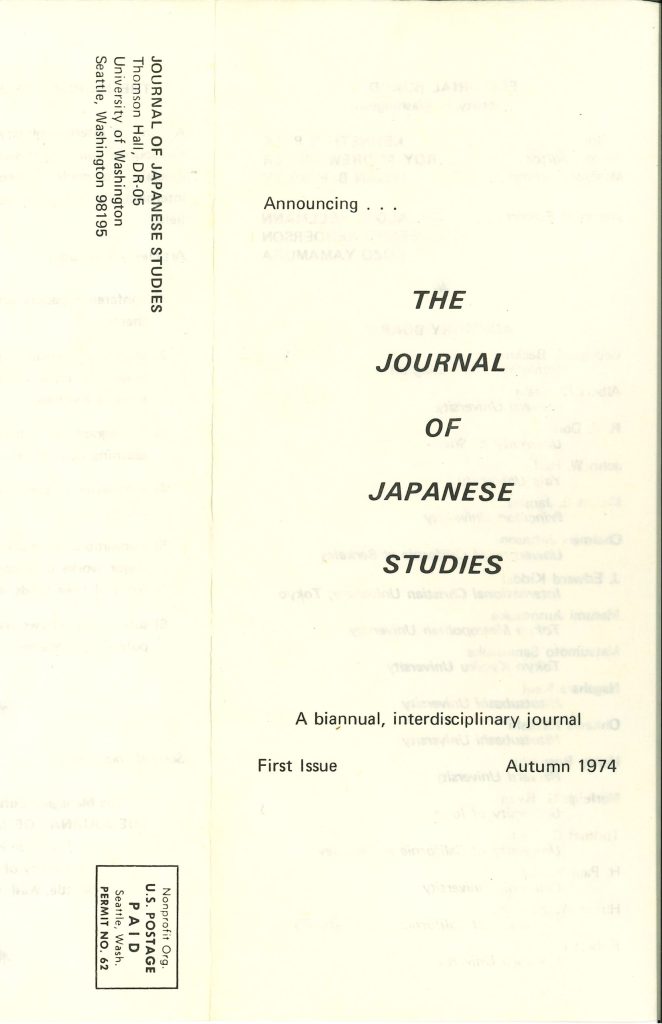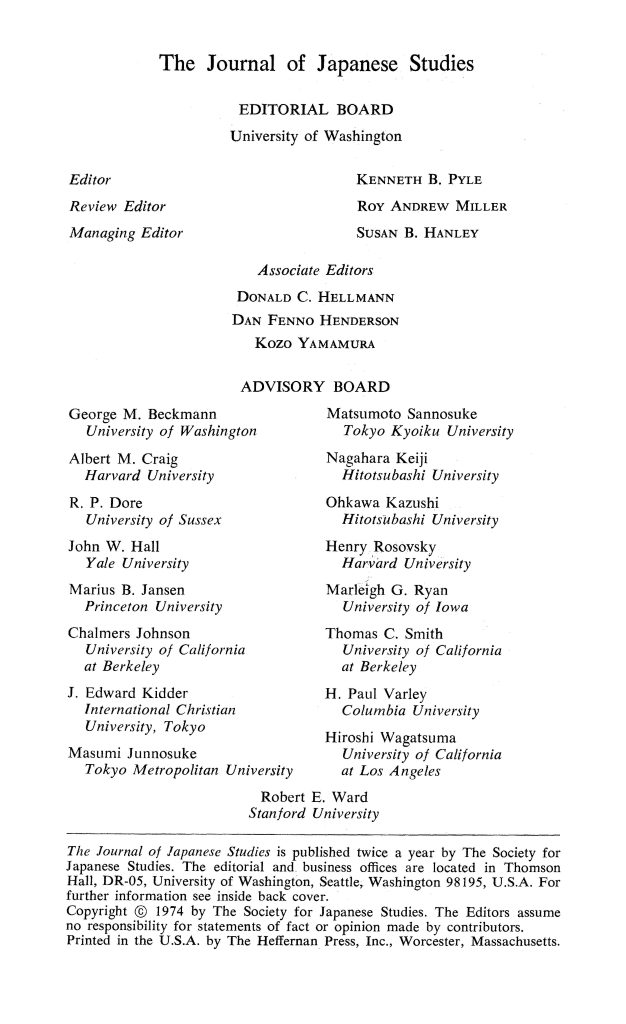December 14, 1972: Editorial planning meeting to discuss JJS. Agenda:

December 5, 1974: Volume 1, Number 1 published. The founding editor’s speech given at the launch party reveals details of the prehistory of JJS:

The first brochure for the Journal:


The original masthead:

April 5, 1975: JJS reviewed in The Japan Times by Donald Richie:

June 9, 1975: The Japan Foundation begin its special purchase of 200 copies of each issue for distribution to libraries around the world unable to purchase copies. This distribution continues until 2023.
April 11, 1977: The Japan-United States Friendship Commission recognizes the “high quality” of JJS and begins grant support that continues in various forms in most years until 2008.
February 1979: JJS introduces “The World Seen From Japan,” occasional translations of articles of unusual interest from influential molders of public opinion. Read the introduction and first translation.
August 1979: The newly established Suntory Foundation begins a 5-year grant to JJS.

October 4, 1979: JJS pays back start-up loan from the University of Washington.
August 1982: JJS initiates Opinion and Comment section “to include personal statements of opinion or comment dealing with items published in recent issues.”
March 30, 1984: The Kyocera Corporation grants $50,000 to establish an endowment for JJS.
May 2, 1986: Susan B. Hanley becomes editor; Kenneth B. Pyle becomes chair of the Editorial Board; Martha Lane Walsh becomes managing editor.
December 1, 1987: JJS becomes the first scholarly journal to receive a challenge grant from the National Endowment for the Humanities. To qualify for $50,000 from NEH, JJS raises $150,000 over three years through the generosity of corporations, foundations, universities, and many individual supporters and adds $200,000 to its endowment. The NEH fundraising campaign announcement:

Major donors:

August 1988: Occasional lists of recent Publications of Note added to JJS.
October 1992: JJS subscription records shift from 3×5-inch index cards to FoxPro software.
November 1, 1996: The Freeman Foundation awards a 3-year, $45,000 grant to support the continued publication of JJS.
July 1, 1998: John Whittier Treat becomes coeditor with Susan Hanley.
May 14-15, 1999: Silver (25th) Anniversary Symposium.
June 8, 2001: JJS back issues published on JSTOR.
January 1, 2004: Susan Hanley’s term ends; Marie Anchordoguy becomes coeditor.
February 1, 2004: JJS current issue goes live on Project MUSE.
2005: Print subscriptions peak at 1,300.
February 7, 2006: 1,000th submission received.
August 2006: Susan Napier’s “Matter Out of Place: Carnival, Containment, and Cultural Recovery in Miyazaki’s Spirited Away” published, likely the most-read JJS article.
May 3, 2008: John Treat’s term ends; Kevin M. Doak becomes coeditor.
April 1, 2015: Marie Anchordoguy’s term ends; Janet Hunter becomes editor.
July 15, 2015: James Dobbins joins Janet Hunter as coeditor.
2016: Last year of University of Washington grants to JJS. Substantial in-kind support continues to present.
July 15, 2018: James Dobbins’s term ends; Morgan Pitelka becomes coeditor.
August 2020: Kenneth B. Pyle Prize for Best Article in JJS launched.
June 2022: Janet Hunter’s term ends; Sabine Frühstück becomes coeditor.
2023: 15 charter subscribers remain among JJS’s individual subscribers.
2024: JJS celebrates 50 years of publication and makes changes to launch the next 50. Stay tuned for new developments!



